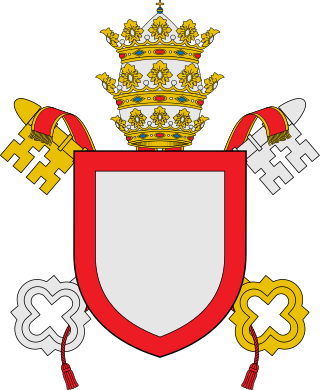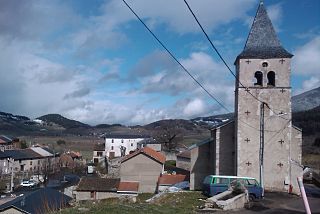
In the Middle Ages, the Cathar yellow cross was a distinguishing mark worn by repentant Cathars, who were ordered to wear it by the Roman Catholic Church.

In the Middle Ages, the Cathar yellow cross was a distinguishing mark worn by repentant Cathars, who were ordered to wear it by the Roman Catholic Church.
Catharism was a religious movement with dualistic and Gnostic elements that appeared in the Languedoc region of France around the middle of the 12th century. Cathars were dualist in their beliefs, and the Catholic symbol of the crucifix was, to the Cathars, a negative symbol. In the words of one 14th century Cathar Perfect Pierre Authié:
...just as a man should with an axe break the gallows on which his father was hanged, so you ought to try and break crucifixes, because Christ was suspended from it, albeit only in seeming.
The office of the Inquisition was formulated in response to Catharism, and a crusade was ultimately declared against Catharism.
Repentant first offenders (who admitted to having been Cathars), when released on licence by the inquisition were ordered to:
...carry from now on and forever two yellow crosses on all their clothes except their shirts and one arm shall be two palms long while the other transversal arm shall be a palm and a half long and each shall be three digits wide with one to be worn in front on the chest and the other between the shoulders.
In addition they were ordered "...not to move about either inside or outside" their houses and were required to "...redo or renew the crosses if they are torn or are destroyed by age."
At the time these crosses were known locally as "las debanadoras" - which in Occitan literally meant reels or winding machines. It is thought that this name is derived from the fact that the Cathars compared the cross to a reel and line to which the wearer was tied, and by which the wearer could be reeled in at any time, for a second offense meant the death penalty.
An example of this type of punishment is to be found in the French village of Montaillou, one of the last bastions of the Cathar belief; here the local Bishop and future Pope, Jacques Fournier launched an extensive inquisition which involved dozens of lengthy interviews with the locals, which were all faithfully recorded. When Fournier became Pope he brought the records with him and they remain to this day in the Vatican Library.
Examples of residents from Montaillou being forced to wear the cross include:
Catharism was a Christian quasi-dualist or pseudo-Gnostic movement which thrived in Southern Europe, particularly in northern Italy and southern France, between the 12th and 14th centuries. Denounced as a heretical sect by the Catholic Church, its followers were attacked first by the Albigensian Crusade and later by the Medieval Inquisition, which eradicated the sect by 1350. Many thousands were slaughtered, hanged, or burnt at the stake, sometimes without regard for "age or sex."

The Inquisition was a judicial procedure and a group of institutions within the Catholic Church whose aim was to combat heresy, apostasy, blasphemy, witchcraft, and customs considered deviant. Violence, torture, or the simple threat of its application, were used by the Inquisition to extract confessions and denunciations from heretics. Studies of the records have found that the overwhelming majority of sentences consisted of penances, but convictions of unrepentant heresy were handed over to the secular courts, which generally resulted in execution or life imprisonment. The Inquisition had its start in the 12th-century Kingdom of France, with the aim of combating religious deviation, particularly among the Cathars and the Waldensians. The inquisitorial courts from this time until the mid-15th century are together known as the Medieval Inquisition. Other groups investigated during the Medieval Inquisition, which primarily took place in France and Italy, include the Spiritual Franciscans, the Hussites, and the Beguines. Beginning in the 1250s, inquisitors were generally chosen from members of the Dominican Order, replacing the earlier practice of using local clergy as judges.

The Medieval Inquisition was a series of Inquisitions from around 1184, including the Episcopal Inquisition (1184–1230s) and later the Papal Inquisition (1230s). The Medieval Inquisition was established in response to movements considered apostate or heretical to Roman Catholicism, in particular Catharism and Waldensians in Southern France and Northern Italy. These were the first movements of many inquisitions that would follow.

Pope Benedict XII, born Jacques Fournier, was head of the Catholic Church from 30 December 1334 to his death, in April 1342. He was the third Avignon pope and reformed monastic orders and opposed nepotism. Unable to remove his capital to Rome or Bologna, Benedict started the great palace at Avignon. He settled the beatific vision controversy of Pope John XXII with the bull Benedictus Deus, which stated that souls may attain the "fullness of the beatific vision" before the Last Judgment. Despite many diplomatic attempts with Emperor Louis IV to resolve their differences, Benedict failed to bring the Holy Roman Empire back under papal dominance. He died 25 April 1342 and was buried in Avignon.

The Albigensian Crusade or Cathar Crusade (1209–1229) was a military and ideological campaign initiated by Pope Innocent III to eliminate Catharism in Languedoc, what is now southern France. The Crusade was prosecuted primarily by the French crown and promptly took on a political aspect. It resulted in the significant reduction of practicing Cathars and a realignment of the County of Toulouse with the French crown. The distinct regional culture of Languedoc was also diminished.

The yellow badge, also known as yellow patch, Jewish badge or yellow star, was a badge that Jews were ordered to wear by some caliphates during the Middle Ages, some European powers during the Medieval and early modern periods, and Nazi officials in World War II. The badges marked the wearer as a religious or ethnic outsider, often as a badge of shame.

Montaillou is a commune in the Ariège department in the south of France. Its original, medieval location was abandoned and the current village is a short distance away.
Pierre Clergue was a priest in the village of Montaillou, France in the late thirteenth and early fourteenth century. He is the central figure in Emmanuel Le Roy Ladurie's 1975 book Montaillou, a pioneering work of microhistory. Since then he has appeared in a number of other histories, and as the villain in the fictional work The Good Men by Charmaine Craig.
Raymonde Arsen née Vital was a servant in the Comté de Foix in the early fourteenth century. She was made notable by appearing in Emmanuel Le Roy Ladurie's Montaillou. Born in Prades d'Aillon to a poor peasant family in 1306 she left to work in the home of Bonet de la Coste in town Pamiers.
Pierre Maury was a shepherd in the Comté de Foix. His life is known through his deposition, and the depositions of his friends and associates, to Bishop Jacques Fournier who was hunting for Cathar heretics. He plays a prominent role in Emmanuel Le Roy Ladurie's study Montaillou, village occitan de 1294 à 1324 and in some ways is that book's protagonist.
Béatrice de Planissoles, was a Cathar minor noble in the Comté de Foix in the late thirteenth and early fourteenth century. She was born circa 1274, probably in the mountain village of Caussou.
Grazide Lizier née Fauré was a peasant in the Comté de Foix in the late thirteenth and early fourteenth century. Her home region was known for being Cathar, and, during an anti-Cathar inquisition carried out by Catholic authorities, she was interrogated. A number of facts about her are recorded in the Fournier Register, and her life, along with those of her fellow villagers, was analyzed in Emmanuel Le Roy Ladurie's Montaillou.
The Fournier Register is a set of records from the inquisition into heresy run by Jacques Fournier, Bishop of Pamiers between 1318 and 1325. Fournier was later to become Pope Benedict XII.

A pectoral cross or pectorale is a cross that is worn on the chest, usually suspended from the neck by a cord or chain. In ancient history and the Middle Ages, pectoral crosses were worn by both clergy and laity. By the Late Middle Ages, the pectoral cross came to be a special indicator of position worn by bishops. In the Roman Catholic Church, the wearing of a pectoral cross remains restricted to popes, cardinals, bishops and abbots. In Eastern Orthodox Church and Byzantine Catholic Churches that follow a Slavic Tradition, priests also wear pectoral crosses, while deacons and minor orders do not. The modern pectoral cross is relatively large, and is different from the small crosses worn on necklaces by many Christians. Most pectoral crosses are made of precious metals and some contain precious or semi-precious gems. Some contain a corpus like a crucifix while others use stylized designs and religious symbols.
Yellow Cross may refer to:
Perfect was the name given by Bernard of Clairvaux to the leaders of the mediaeval Christian religious movement in southern France and northern Italy commonly referred to as the Cathars. The Perfecti were not clerics in any way, but merely members who had become 'adepts' in the teaching, and whose role was that of aiding other ordinary members achieve the rewards of belief and practice. The term reflects the fact that such a person was seen by the Catholic Church as the "perfect heretic". As "bonhommes", Perfecti were expected to follow a lifestyle of extreme austerity and renunciation of the world which included abstaining from eating meat and avoiding all sexual contact. They were thus recognized as trans-material angels by their followers, the Credentes. Perfecti were drawn from all walks of life and counted aristocrats, merchants and peasants among their number. Women could also become Perfecti and were known as Parfaites or Perfectae.

Caussou is a commune in the Ariège department in the Occitanie region in southwestern France.

Cathar castles are a group of medieval castles located in the Languedoc region. Some had a Cathar connection in that they offered refuge to dispossessed Cathars in the thirteenth century. Many of these sites were replaced by new castles built by the victorious French Crusaders and the term Cathar castle is also applied to these fortifications despite their having no connection with Cathars. The fate of many Cathar castles, at least for the early part of the Crusade, is outlined in the contemporary Occitan "Chanson de la Croisade", translated into English as the "Song of the Cathar Wars ".
Credentes or Believers, were the ordinary followers of what became known as the Cathar or Albigensian movement, a heretical sect which flourished in western Europe during the 11th, 12th and 13th centuries. Credentes constituted the main part of the Cathar community in the region. Although Catharism sprang up in Spain, the Rhineland, Flanders and Italy its main focus was in the southern region of France, particularly the area known as the Languedoc. Although pacifist in nature, Catharism drew the condemnation of the Catholic Church which, when persuasion failed, launched successive Crusades and instigated the Inquisition to destroy it.

Montaillou is a book by the French historian Emmanuel Le Roy Ladurie first published in 1975. It was first translated into English in 1978 by Barbara Bray, and has been subtitled The Promised Land of Error and Cathars and Catholics in a French Village.